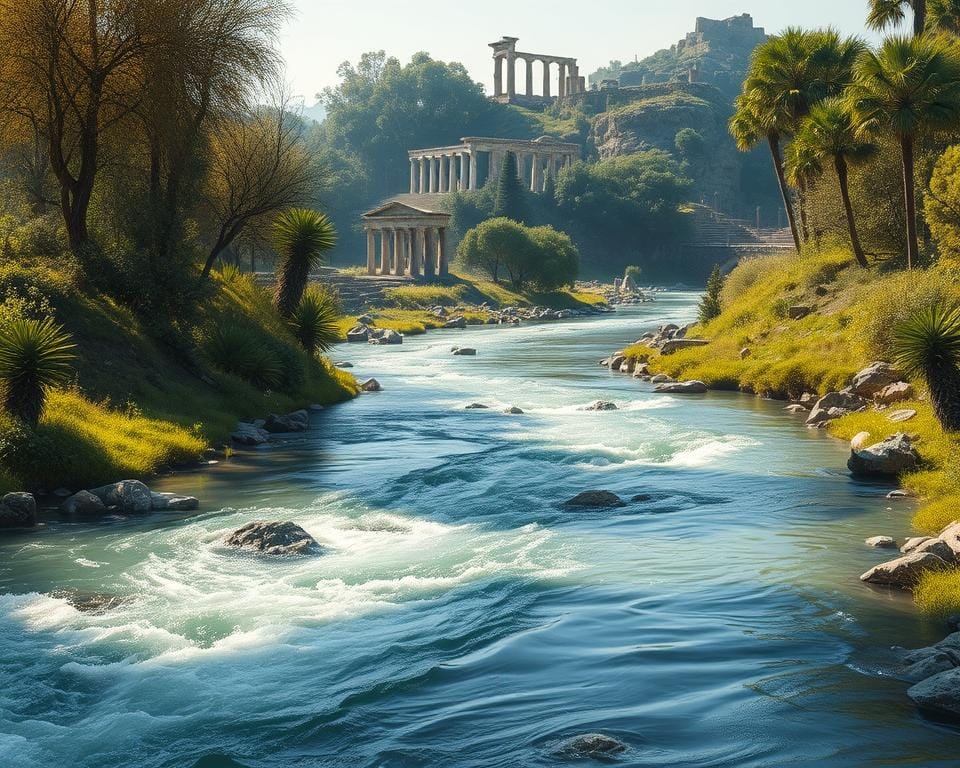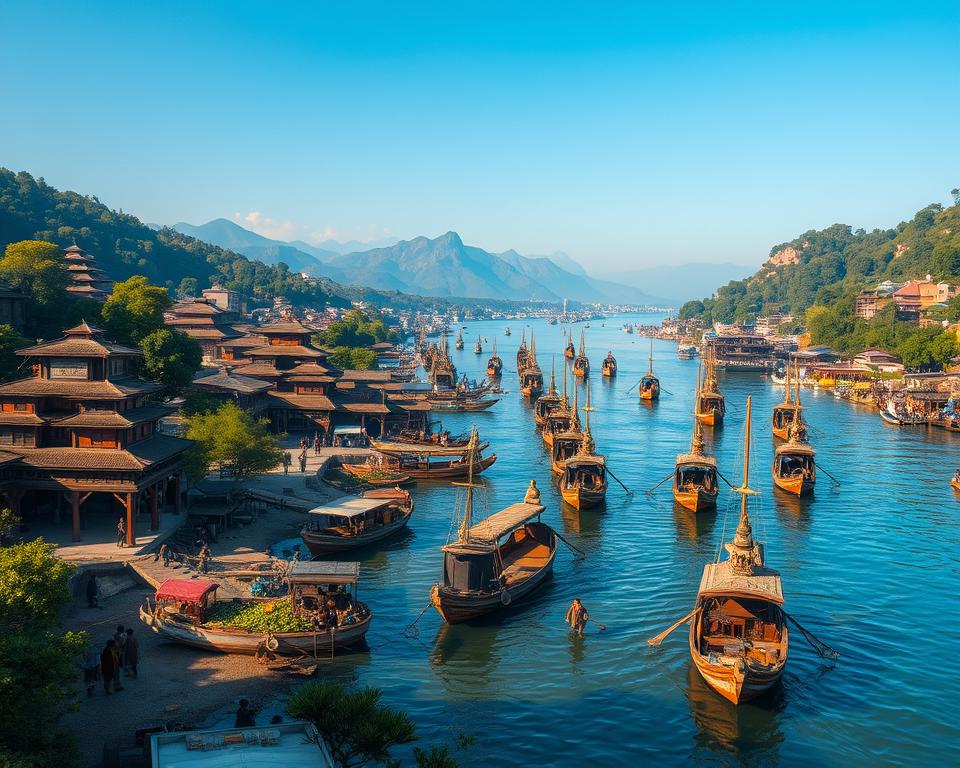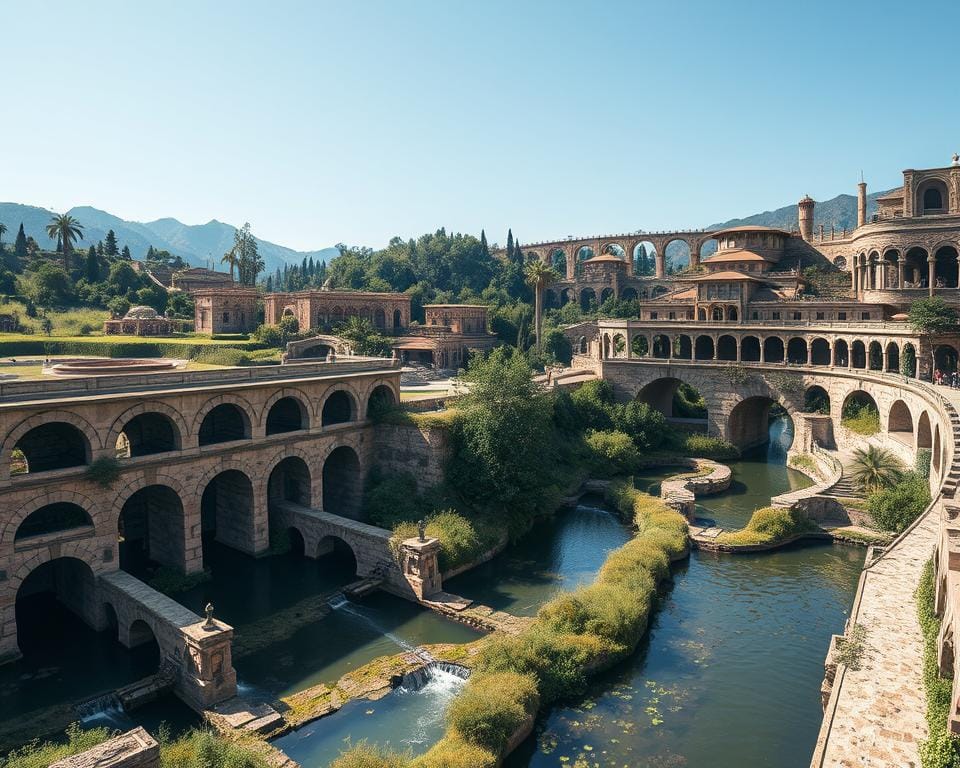Water was essential for early civilizations and central to their development. Ancient societies depended on smart water management. By 6000 BC, the Mesopotamians built canals, dikes, and reservoirs against flooding and droughts. This shows they understood water’s importance early on.
Ancient Egypt mastered basin irrigation to control Nile River floods. This technique not only prevented flood damage but also improved soil fertility. Aqueducts throughout history showcase our clever use of water for survival and growth. Water also shaped cultures and religions, like the Ganges River in Hindu mythology, seen as goddess Ganga.
The Chimú civilization thrived in deserts thanks to ingenious water use, guided by archaeologist Gabriel Prieto’s findings. They built irrigation systems and strong defenses, like the Muralla La Cumbre, to support life in dry lands. Their practices demonstrate early people’s creativity in water management and agriculture.
Irrigation history shows ancient water systems were key to civilizations. The Romans’ aqueducts and Persians’ qanats reveal their engineering skills and water’s role in their success. For more details, visit this insightful resource.
The Importance of Water in Human Settlements
Water was crucial in forming and growing ancient communities. It influenced the success and sustainability of early human settlements. From settlement water sources to agricultural water management, water played a key role.
The Foundation of Early Communities
The impact of water on early communities was huge. About 10,000 years ago, people started forming permanent settlements. Some, like those in the Tigris-Euphrates and Nile valleys, date back 6,000 years. Others, in the Indus and Ganges valleys, and the Huang He valley, are nearly as ancient. Water availability decided their fate.
Having a reliable water source was vital for these communities. In Mesopotamia, advancements allowed for water control through canals, dikes, and reservoirs. This provided a steady water supply, helping communities to prosper.
Water as a Resource for Agriculture and Daily Life
Water was essential not just for drinking and hygiene but also for farming. Early irrigation techniques by ancient civilizations show this. The Nile River, for example, was crucial for Egyptian irrigation, supporting their agriculture and wealth.
About 4,000 years ago, the first large irrigation system appeared in the Yangtze catchment. Such systems demanded strong community cooperation and advanced engineering. They made the difference between success and failure, showing water’s role in ancient development.
| Region | Timeline (Years Before Present) | Notable Developments |
|---|---|---|
| Tigris-Euphrates Valley | 6,000 | Canals, dikes, reservoirs |
| Nile Valley | 6,000 | Basin irrigation |
| Indus River Valley | 4,500 | Advanced irrigation |
| Ganges Valley | 3,000 | Seasonal flooding management |
| Huang He Valley | 4,000 | Flood defense practices |
| Yangtze Catchment | 4,000 | Large irrigation systems |
Water’s role in ancient civilizations was crucial. It was key to settlement and agricultural management. This shows the ingenuity and resilience of our ancestors in creating lasting settlements.
Engineering Marvels: Ancient Water Management Systems
Throughout history, civilizations crafted clever ways to handle their water needs. These amazing projects show their skill and deep knowledge of water engineering. They are a testament to human ingenuity in managing nature’s most vital resource.
The Roman Aqueducts
The Roman aqueducts are proof of remarkable engineering and urban growth. Rome’s first aqueduct, the Aqua Appia, was built in 312 BC. It was the start of a system that included 11 major aqueducts. The Aqua Claudia, finished in 52 AD, stretched over 45 miles.
This system used arches, tunnels, and a special kind of concrete. It shows how Romans moved water over great distances without pumps. Their work allowed cities to thrive by bringing water from afar, using gravity and smart design.
The Qanats of Persia
The qanat system from Persia brought a new way to manage water. It moved water from mountain aquifers to dry plains through underground tunnels. This innovation helped to green arid lands and grow communities.
By linking vertical shafts with sloping tunnels, water flowed naturally. This method boosted agriculture and helped Persian culture spread. It shows early engineering genius in creating a sustainable water supply.
The Nile River and Egyptian Basin Irrigation
The Nile River was key to Egypt’s water engineering breakthroughs. Egyptians used basin irrigation to manage the river’s floods. They built basins and canals to channel water to their crops.
This technique increased farm outputs, ensuring food for the people and aiding city development. The clever use of the Nile’s waters was crucial for Egypt’s success. It’s a great example of how ancient people adapted to and harnessed natural cycles.
The Chimú Civilization’s Water Innovations
The Chimú civilization flourished in Peru from 900 AD until the Inca took over in the 15th century. They were masters at managing water. Using irrigation techniques and desert water management, they turned dry land into fertile farms.
Desert Farming Techniques
The Chimú were ahead of their time in farming. They knew how to farm in the desert using desert farming techniques. By adding nutrient-rich sediments as fertilizers and choosing crops that needed little water, they succeeded in difficult conditions. They mainly grew maize, beans, and cotton. Their way of managing nutrients is still praised today.
Construction of Aqueducts and Canals
The Chimú built an extensive network of aqueducts and canals to move water to where it was needed most. This system was crucial for their desert water management. It brought water from far away to both cities and farms. Thanks to their engineering, they could irrigate crops all year long.
Dealing with Seasonal Flooding
Seasonal flooding was a big problem, but the Chimú had solutions. Through Chimú innovations, they managed the floods. They constructed reservoirs and channels to store and redirect excess rainwater. This approach protected them from floods and kept their water supply steady through dry and wet seasons.
| Feature | Details |
|---|---|
| Aqueducts and Canals | Extensive network ensuring consistent water supply |
| Desert Farming | Innovative techniques using nutrient-rich sediments |
| Flood Control | Reservoirs and diversion channels to manage seasonal flooding |
| Crops | Maize, beans, and cotton |
| UNESCO Site | Chan Chan, the capital, designated in 1986 |
Water in Ancient Civilizations: A Cultural Perspective
Water played a key role in ancient cultures, mixing with their beliefs and arts. From Egypt’s Nile to India’s Ganges, water shaped ancient life everywhere.

Water in Mythology and Religion
In Egypt, the Nile was both worshipped and linked to fertility. Its floods brought life to the fields. In Hindu beliefs, the Ganges River, seen as goddess Ganga, stands for purity and salvation. A dip in its waters is thought to wash away sins.
In Japan’s Shinto belief, water cleanses. At shrines, a water basin lets visitors purify themselves. In Africa, Yoruba people honor Oshun, a goddess of rivers, for fertility, love, and success.
Greeks had sea god Poseidon, showing the ocean’s might. Sacred rivers and springs, like the Styx, were vital to them. Norse myths tell of a wisdom well beneath Yggdrasil, the world tree. Mesopotamians also held water sacred in their faith practices.
Artistic Representations of Water
Water’s impact on art was huge, seen in textiles, paintings, and sculptures. The Chimú used water designs, echoing its significance in life and spirit. Egyptians’ art showed the Nile’s ties to life and renewal.
Water themes appeared across cultures in art. This included healing springs in Native American artworks. They expressed water’s vital and cleansing roles.
Sacrificial Rituals and Water Deification
Water and sacrifices often linked in ancient times. The Chimú made sacrifices to counter severe weather. Christian baptism, with ancient roots, uses water for spiritual cleansing and joining the faith.
Hindu rituals also highlight water for purification, showing its sacred nature in worship. These practices underline water’s cherished role across different cultures.
For more insights into water’s ancient roles, check this detailed article.
El Niño and Its Impact on Ancient Civilizations
El Niño had a big impact on ancient groups, with the Chimú in Peru as a key example. These events brought lots of rain and cooler air to the area. This caused floods and storms that the Chimú had to deal with.
To handle these challenges, the Chimú came up with smart solutions. They made long aqueducts and canals to move water to their crops. They also built a big wall to keep their homes safe from floods.
Yet, the Chimú still faced problems because of El Niño. To make their gods happy and control the weather, they performed sacrifices. At a site near Chan Chan, 269 young victims show how serious they were. These kids were offered to the gods during big El Niño events.
By dealing with these weather problems, the Chimú showed amazing adaptability. They picked sacrificial children from many places, showing how El Niño affected their beliefs and actions. This effort is detailed in an online article about ancient weather adaptation.
The Role of Rivers in Shaping Trade and Commerce
Rivers were like natural highways in ancient times, shaping trade and commerce. They helped people and regions interact and grow economically. By looking at how rivers made trading routes, we understand their role in connecting societies. This helped spread goods, culture, and ideas.

Rivers as Natural Highways
Ancient groups, like the Egyptians and Mesopotamians, lived by rivers such as the Nile and Tigris-Euphrates. Rivers were crucial for these civilizations. They offered a steady way to move goods and people far and wide. For example, the Nile let traders move goods from Africa to the Mediterranean and further.
The Trade Networks Along Major Rivers
Trade routes along big rivers boosted ancient economies. Take the Tigris-Euphrates rivers in Mesopotamia. They were key for local and long-distance trade. These river routes also helped connect different peoples. They were essential for sharing new technologies and cultural ideas. Learn more about the role of rivers in trade at river trade routes.
Conclusion
Water’s role in the growth of civilizations is incredibly important. A map of early human civilization shows this clearly. It covers the period from about 8000 BCE to 2000 BCE. We learn about the birth of organized societies, farming, and city life. The Tigris and Euphrates rivers fed Mesopotamia. The Nile supported Egypt. The Indus nurtured the Harappan civilization. And the Yellow River helped China’s early dynasties grow.
These rivers had floods that brought fertile silt to the lands. This was perfect for growing crops. It also led to the creation of irrigation methods. Civilization began to rely on water for more than just survival. They moved from hunting for food to growing it. This allowed them to have extra food, which they could trade.
This change meant people could settle in one place. They could build homes and grow their communities. Trade brought wealth and helped different groups connect. It led to the creation of social classes and governments.
Different river civilizations made their own contributions to history. They developed cities, art, writing, and science. They even saw rivers as gods, showing how important water was to them spiritually. Innovations like the qanat system and Roman aqueducts show water’s role in progress. These ancient ideas shaped the way societies operated. They show how important it is to use natural resources wisely, keep order, and build a united community.

